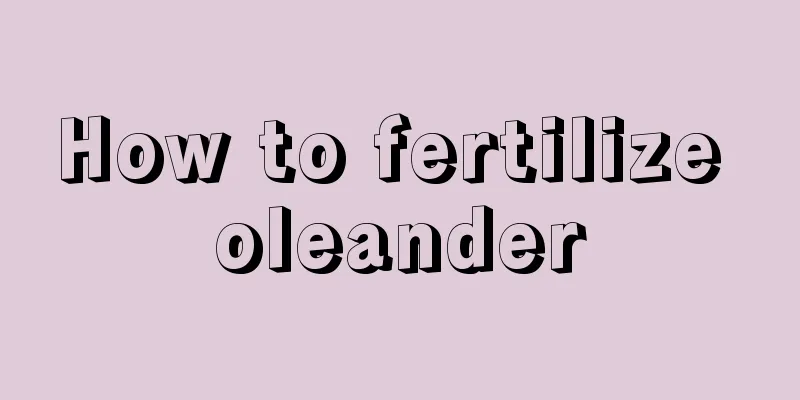How to fertilize oleander

1. How to choose fertilizer for oleanderIf you want flowers to grow well, fertilization is the key. So how should you fertilize oleander? First of all, we need to choose the right fertilizer. As we all know, there are many kinds of fertilizers, including specially produced chemical fertilizers, homemade farmyard manure, etc. It is not recommended to use chemical fertilizers for fertilizing oleander. You can make your own farmyard manure: animal manure and urine are rich in nitrogen, which can promote the growth of oleander plants and is an indispensable fertilizer for growth and development. However, it should not be used in excess, as excessive use will prevent the flowers from blooming. The principles of using this fertilizer are to use it dilute, light, less and frequently to prevent the roots from being burned; animal bones are rich in phosphorus, so fish bones and other bones can be crushed or ground into powder and used as base fertilizer for potted plants; plant fertilizers such as peanut cake water or bean cake water are rich in potassium, which can be used as base fertilizer for potted plants or as top dressing after fertilization. 2. Fertilization method of oleanderOleander plants are very large and have a long flowering period, so fertilization is very necessary. Before flowering, fertilize at least twice a month; during the flowering period, apply more phosphorus and potassium rich fertilizers, and topdress every 10 days; it is best to fertilize 1-2 more times in winter. For potted oleander, apply enough base fertilizer when repotting in spring, and then it is best to apply top dressing once a week, which is rich in potassium and phosphorus. After the oleander takes root, the number of fertilizations can be reduced, but remember not to apply too much or only one type of fertilizer. 3. Precautions for fertilizing oleander1. Oleander prefers neutral or acidic soil. It is best not to use alkaline fertilizers such as wood ash when fertilizing. 2. When transplanting potted plants, you can add 15% chicken manure to the soil in the pots, and keep the organic fertilizer at around 20%, not too much. 3. When the temperature is high in summer, for example, above 30 degrees Celsius, fertilization should be suspended to avoid fertilizer accumulation and damage to oleander. 4. The stems and leaves of oleander contain a variety of toxins. When fertilizing, be careful not to damage the stems and leaves to avoid poisoning. |
<<: How to grow rhododendron at home
Recommend
Cultivation methods and precautions of stinking peony
How to cultivate stinking peony illumination The ...
How much water should be used for spring grass at one time
1. How much water to pour Spring grass likes mois...
When to transplant persimmon trees
Persimmon trees are suitable for a wide range of ...
How to take care of the money tree?
Money Tree Growing Conditions For the money tree,...
How to make Chinese evergreen bloom and where to pick the tips
1. How to make the pot explode 1. Suitable soil: ...
Tips for cuttings of green radish
Prepare the Materials Quick rooting powder (avail...
The Difference Between Lantana and Verbena
1. Different varieties Lantana is a plant belongi...
How much water to add to the hydroponic culture of Anthurium
1. How much water to add When growing Anthurium h...
Air Purifying Plants
1. Fortune Tree The money tree has a strong abili...
The cultivation methods and precautions of Dianthus superbus
Characteristics of Superbus As I said, only by un...
Bayberry potted plant maintenance method, what are the precautions
1. Suitable potting soil When caring for bayberry...
What are the five grains and how to make five grain rice
1. Rice Rice refers to rice, which is also known ...
What should I do if the roots of hyacinth are moldy? Can it still survive?
1. What to do if the roots of hyacinth are moldy ...
Beibei pumpkin planting method and time outdoor planting and management technology
Beibei pumpkin planting time The planting time of...
What are the minefields of flower cultivation?
1. Be careful with flowers that have strong fragr...









